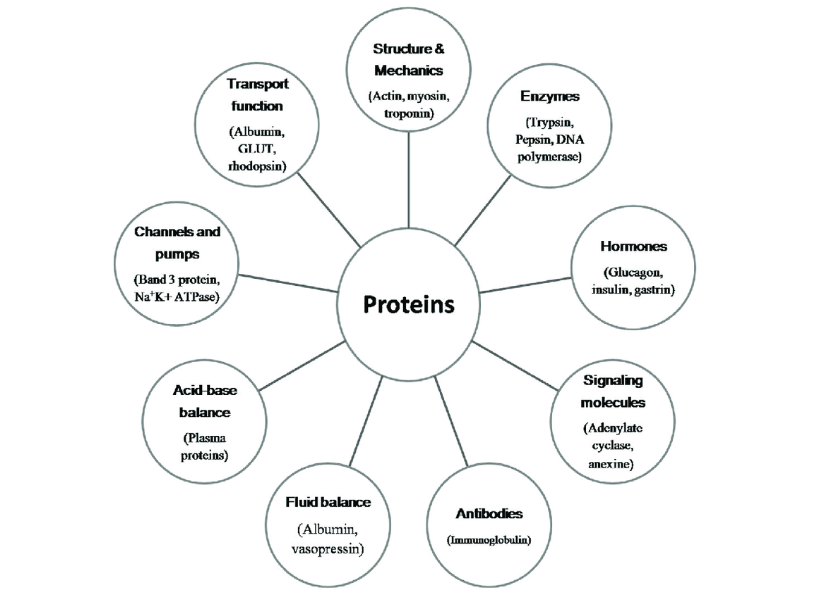Importance of Protein and Calcium in Bone Health
Importance of Protein and Calcium in Bone Health
Protein and calcium are essential components of bone tissues. The composition of our bones consists of approximately 50-60% minerals, primarily hydroxyapatite crystals. The remaining 20-40% is an organic matrix, with type 1 collagen comprising 90% of the total bone protein, along with 5-10% water and some lipids. This composition forms the structure of our bones, highlighting the importance of protein in bone health.
Aside from bone structure, proteins play crucial roles in various bodily functions. They are utilized in transportation, as seen in transferrin and hemoglobin, which are proteins used for carrying nutrients and oxygen in the blood. Proteins are also vital for the central nervous system, contributing to nerve growth and functioning through proteins like laminin. Additionally, proteins are involved in wound healing, tissue regeneration, and provide energy and satiation in the body.
Proteins are crucial for maintaining fluid balance and acid-base regulation. Hemoglobin and albumin, both proteins, help in maintaining the body’s pH balance. Many hormones, such as insulin and growth hormone, are protein-based. Enzymes like amylases and pepsin aid in digestion, while proteins like lysozyme and antibodies are essential for immunity.
Proteins also contribute to the structure and mobility of our body. Keratin is present in hair, collagen in skin, and elastin in muscles and skin, providing structural support. Actin and myosin, found in muscles, enable mobility. These proteins are vital for the proper functioning of our body and emphasize the importance of including an adequate amount of protein in our diet.

Dietary protein plays a crucial role in increasing intestinal calcium absorption. If protein levels in our body are insufficient, calcium absorption and reabsorption at the cellular level may be affected, potentially leading to weakened bones. This can result in an increase in insulin-like growth factor (IGF), a key mediator in bone health that improves lean muscle mass and strength, ultimately impacting bone mineral density (BMD). Maintaining correct protein levels ensures proper BMD and energy levels, as 10-15% of our energy is derived from protein.
IGF behaves similar to insulin, acting as a hormone that activates growth. It plays a significant role in regulating growth hormone levels, which can fluctuate based on dietary factors. Fluctuations in IGF can lead to changes in growth hormone levels, affecting growth. Monitoring IGF levels through testing can help determine if growth hormone levels are adequate, as growth hormone levels can vary.
Dietary protein serves as a crucial source of energy, especially during periods of fasting, starvation, or when food intake has been inadequate for an extended period. In such situations, the body derives energy from glycogen and fat stores. Glycogen is stored in muscles and the liver, and if these stores are depleted, the body utilizes protein for energy. During activities like racing or exercising, protein also provides energy.
When your calorie intake is insufficient or inadequate, the body metabolizes protein to provide energy. Protein serves as a source of energy and is essential for brain function. However, protein is considered the last resort for providing glucose to the brain. When protein is used for energy, it is termed amino acid wasting, as proteins are made up of amino acids. There are 20 types of amino acids, which combine to form various types of proteins essential for the body’s functions.
Positive Effects of Protein:-
Bone Health: Providing dietary protein and calcium to someone with a fracture can accelerate their recovery. This could be due to the presence of insulin-like growth factor (IGF) in the bone matrix, which promotes osteoblasts. Osteoblasts are cells that help in bone regeneration and have the capacity for regrowth. Stimulating osteoblasts through IGF can aid in healing fractures, highlighting the vital role of protein in bone malfunction scenarios.
Urinary Calcium Loss: Protein can increase urinary calcium loss, which, while necessary for IGF activation, may not be beneficial in the long run. Studies have shown a hypothesis that these losses lead to IGF activation, but the long-term effects are unclear. Protein supplements have become popular due to their observed fast recovery rates in patients receiving them over extended periods.
Negative Effects of Protein:
Acid Production: The metabolism of sulfur amino acids in protein can produce acids, which can have negative effects on bone health.
Osteoblast and Osteoclast Activity:Protein can decrease osteoblast (bone-building) activity and increase osteoclast (bone-resorbing) activity, potentially affecting bone health.
Urinary Excretion:rotein can increase urinary excretion, which can impact calcium balance and bone health.
In support of bone health, protein supplies amino acids for collagen synthesis in the bone matrix, increases bone formation, and decreases bone resorption and intestinal absorption.
While protein is essential for various bodily functions, including bone health, the emphasis should be on obtaining protein from dietary sources rather than supplements. Naturopathy practitioners do not typically promote protein supplements, except in cases of advanced age or critical conditions. It is important to maintain a balanced diet with adequate protein for overall health and well-being.
Functions of Protein:
Proteins play several essential roles in the body, including:
- Cell Structure: Proteins are integral to the structure of all cells in the body.
- Enzymes: Proteins act as enzymes, facilitating biochemical reactions in the body.
- Hormones: Several hormones, such as insulin and growth hormone, are protein-based.
- Transport Carriers: Proteins transport molecules, such as oxygen (hemoglobin) and lipids (lipoproteins), throughout the body.
- Immunoglobulins: Proteins play a crucial role in the immune system as immunoglobulins.
- Osmotic Pressure: Proteins help maintain osmotic pressure in cells.
- Blood Clotting: Proteins are involved in the clotting of blood.
- Muscle Contraction: Proteins are essential for muscle contraction.
During starvation, proteins, specifically amino acids, serve as the major suppliers of energy.

Protein Digestion in the Mouth:
The first step in protein digestion is chewing, which mechanically breaks down large protein pieces into smaller pieces. Saliva aids in swallowing and the passage of partially mashed protein through the esophagus. Protein digestion primarily occurs in the stomach due to its acidic environment, which denatures proteins. Insulin is given through injections because it is a protein and would be denatured in the stomach if taken orally.
Pepsin, an enzyme in the stomach, begins breaking peptide bonds, creating shorter polypeptides. Protein digestion takes longer than carbohydrate digestion. When we consume high-protein foods, they can feel heavy in the stomach due to the presence of hydrochloric acid (HCl). Proteins are converted into peptones and proteoses, and their digestion continues in the intestine with the enzyme trypsinogen, activated by enterokinase, converting it into trypsin.
Proteins that aren’t fully digested in the small intestine pass into the large intestine and are excreted in the feces. Plant-based proteins are less digestible than animal proteins due to some proteins being bound in plant cell walls. Once amino acids are in the blood, they are transported to the liver, where they become part of the body’s amino acid pool.
In critical conditions, supplements may be necessary, but direct interference with the body’s metabolism can sometimes cause harm rather than benefit. Therefore, it is advisable to use supplements only when needed. To use amino acids for energy production, glucose, or fat, nitrogen must first be removed in a process called deamination, which occurs in the liver and kidneys. The nitrogen is converted into urea and excreted in the urine, as excess ammonia is toxic to the body.
Sources of Protein:
According to the Dietary Guidelines for Americans 2015-2020, a healthy eating pattern includes a variety of foods containing protein. Both animal and plant foods can be excellent sources of protein. The guidelines classify the following foods as protein foods:
- Seafood
- Lean meats and poultry
- Eggs
- Legumes, which include beans and peas
- Nuts and seeds
- Soy products
- Dairy products, such as milk, cheese, and yogurt
Whole grains and vegetables also contain some protein, but generally less than other sources. Animal products tend to contain higher amounts of protein than plant foods. Therefore, individuals following a vegetarian or vegan diet may need to plan their meals carefully to ensure they meet their protein needs.
Protein Deficiency:
Protein-energy undernutrition (PEU), previously known as protein-energy malnutrition, is an energy deficit due to a deficiency of all macronutrients. It commonly includes deficiencies of many micronutrients. PEU can occur suddenly and completely (starvation) or gradually.
When malnutrition occurs due to protein deficiency, it can affect a child’s height, weight, and overall growth. The child may either be in a wasted form, with a long height but low weight, or they may be underweight. Proper protein intake is crucial for supporting healthy growth and development in children.
Symptoms and Treatment of Protein Deficiency:
Protein deficiency can lead to various symptoms, including underweight, impaired brain development, decreased appetite, and low blood levels. To treat protein deficiency, it is important to provide adequate protein. A dosage of 1 gram of protein per body weight can be given, and in severe cases, up to 2 grams can be provided. Groundnuts, peas, milk, and leafy vegetables are excellent sources of protein. Meat and fish are also good sources for non-vegetarians. In severe cases such as kwashiorkor, where the entire body appears skeletal, protein supplementation is crucial.
Hypercholesterolemia:
Hypercholesterolemia is a condition that occurs in adults, characterized by high cholesterol levels. One of the reasons for this condition is a high intake of unsaturated fats and low protein intake. It is important to avoid excessive intake of oils and fats in such cases, as it can hinder protein absorption. Obesity can also be caused by inadequate protein intake, as excessive carbohydrate consumption can lead to weight gain. Inadequate protein intake can also lead to vitamin D deficiency, which can manifest as white spots on the skin.
Recommended Dietary Allowances (RDA):
The Recommended Dietary Allowances (RDA) represent the quantities of nutrients needed daily for maintaining good health and physical efficiency. The protein requirement varies with age, with growing children requiring about 2 grams per kilogram of body weight per day, compared to 1 gram per kilogram for adults. For adults, 0.8-1.0 grams of protein per kilogram of body weight per day is adequate. Pregnant and lactating women also have higher protein requirements.
Prevention:
Prevention strategies include educating people about the nutritional quality of common foods, the importance of breastfeeding, and the need for a balanced diet. It is also important to promote the consumption of milk, eggs, meat, or pulses to enhance dietary protein value. Additionally, early detection of malnutrition and intervention are crucial. Naturopathy also emphasizes reducing food intake during illness.
Nutritional Supplementation:
Nutritional deficiencies can often be attributed to a lack of knowledge rather than the cost of food. While some foods like peanut butter may be costly, peanuts themselves are affordable and nutritious. A simple calculation for nutritional supplementation includes 40 grams of whole wheat, 16 grams of chickpeas, 10 grams of groundnuts, and 20 grams of jaggery, totaling 86 grams. This amount may not be sufficient to fill your stomach, so it should be consumed three times a day. If your weight is over 60 kilograms, this amount can provide a satisfying meal. Consuming this mixture would provide approximately 11.3 grams of protein, showing that good protein can be obtained from raw sources.
When we eat food, the body’s digestive system breaks down dietary protein into individual amino acids, which are then absorbed and used by cells to build other proteins and other macromolecules, such as DNA.
Classification of Amino Acids:
Essential amino acids are those that must be obtained from food, as the body cannot produce them. Non-essential amino acids are those that the body can synthesize on its own. While there is a large market for essential amino acids in supplements, 20% of amino acids in natural foods are essential amino acids.
Recommended Dietary Allowances (RDA) in Indians:
For a man performing sedentary work, moderate work, or heavy work weighing 60 kilograms, protein intake may vary. However, aiming for 60 grams of protein per day is generally sufficient. Calcium intake should be around 600 mg per day, and iron also plays a crucial role in metabolism. Consuming 60 grams of protein should ensure normal bodily functions, reducing the need for supplements.
Functions of Structural Proteins:
Structural proteins form components of connective tissue, bone, tendons, cartilage, skin, feathers, nails, hairs, and horns. They are mostly fibrous and insoluble in water. Examples include collagen, keratin, and elastin.
Functions of Enzymes:
Enzymes are biological catalysts that reduce the activation energy of reactions and speed up metabolic reactions in cells. Most enzymes are globular and conjugated proteins. Examples include DNA polymerase, nitrogenase, and lipase.
Functions of Hormones:
Hormones are proteinaceous and regulate various cellular functions.
Functions of Respiratory Pigments:
Respiratory pigments are colored proteins that contain pigments as their prosthetic group. Examples include hemoglobin and myoglobin.
Functions of Transport Proteins:
Transport proteins form channels in the plasma membrane and transport materials in cells. They are also components of blood and lymph. An example is serum albumin.
Functions of Contractile Proteins:
Contractile proteins are responsible for muscle contractions and work with ATP molecules. Examples include actin and myosin.
Functions of Storage Proteins:
Storage proteins store metal ions and amino acids in cells. They are found in seeds, eggs, and milk. Examples include ferritin, casein, ovalbumin, and gluten.
Functions of Toxins:
Toxins are toxic proteins, such as those found in snake venom.
Introduction to Calcium:
Calcium (Ca) is an essential mineral required for various bodily functions, including muscle contraction, nerve conduction, hormone release, and blood clotting. It is also crucial for several metabolic processes that require specific calcium concentrations.
Sources of Calcium:
Calcium is an important nutrient, with a daily intake requirement of approximately 1000 mg per day, roughly equivalent to the amount found in one liter of milk. It is widely distributed in food sources such as milk, cheese, egg yolks, fish, beans, lentils, nuts, and cabbage. A balanced diet can provide an adequate amount of calcium.

Role and Distribution in the Body:
Calcium is the most abundant mineral in the body, with a total content of about 1 to 1.5 kilograms in an adult man. Approximately 99% of this calcium is present in the bones and teeth, providing structural support. The remaining 1% of calcium, found outside the skeletal tissue, plays a crucial role in various functions.
Biochemical Functions:
- Development of Bones and Teeth: Calcium, along with phosphate, is essential for the formation and physical strength of skeletal tissue. Bones are mineralized connective tissues that serve as reservoirs of calcium. Osteoblasts are responsible for bone formation, while osteoclasts result in demineralization.
- Activation of Enzymes: Calcium is needed for the direct activation of enzymes such as lipase (pancreatic), ATPase, and succinate dehydrogenase.
- Calmodulin-Mediated Action of Calcium: Calmodulin is a calcium-binding regulatory protein. The calcium-calmodulin complex activates certain enzymes, such as adenylate cyclase and calcium-dependent protein kinases.
- Calcium as an Intracellular Messenger: Calcium ions play a crucial role as intracellular messengers, mediating various cellular processes.
- Release of Hormones: Calcium is involved in the release of hormones within the body.
- Action on the Heart: Calcium acts on the myocardium and prolongs systole. It plays a role in the rhythmic beating of the heart.
In conclusion, calcium is an essential mineral that plays a vital role in various physiological functions, especially in bone health, enzyme activation, and cellular signaling. Ensuring an adequate intake of calcium-rich foods is essential for overall health and well-being.
Dietary Calcium Requirements:
- Adult men and women: 800 mg/day
- Women during pregnancy and lactation, postmenopause: 1.5 g/day
- Children (1-18 years): 300-500 mg/day
Sources of Calcium:
- Best sources: Milk and milk products
- Good sources: Beans, leafy vegetables, fish, cabbage, egg yolk
Factors Promoting Calcium Absorption:
- Vitamin D: Plays an important role in the absorption and promotion of calcium
- Parathyroid hormone and acidity: More favorable for calcium absorption
- Lactose: Promotes calcium uptake by intestinal cells
- Amino acids lysine and arginine: Facilitate calcium absorption
Regulation of Plasma Calcium:
- Vitamin D converts to calcitriol in the intestine, promoting calcium absorption from the bones
- Parathyroid hormone activates calcitriol, leading to calcium absorption from the renal tubes, increasing plasma levels
Plasma Calcium:
- Normal concentration: 9-11 mg/dl (4.5-5.5 mEq/l)
- Ionized form: 50% (biologically active)
- Complexed with citrate, phosphate, bicarbonate: 10%
- Non-diffusible form: 40%
In conclusion, maintaining adequate calcium levels is essential for various bodily functions, including bone health, muscle contraction, and nerve conduction. Incorporating calcium-rich foods into your diet and ensuring proper absorption through factors like vitamin D can help meet your calcium needs.
Does taking calcium has side effects?
Yes, taking calcium supplements can sometimes cause side effects, although they are generally rare. Some of the side effects that may occur include gas, constipation, and bloating. Calcium carbonate, in particular, is known to be more constipating. It’s advisable to try different brands or types of calcium supplements to find one that you tolerate best.
Furthermore, long-term high protein or high meat intake in humans has been associated with disorders of bone and calcium homeostasis. This suggests that while protein is essential for health, moderation and balance in dietary choices are key to maintaining overall well-being.








